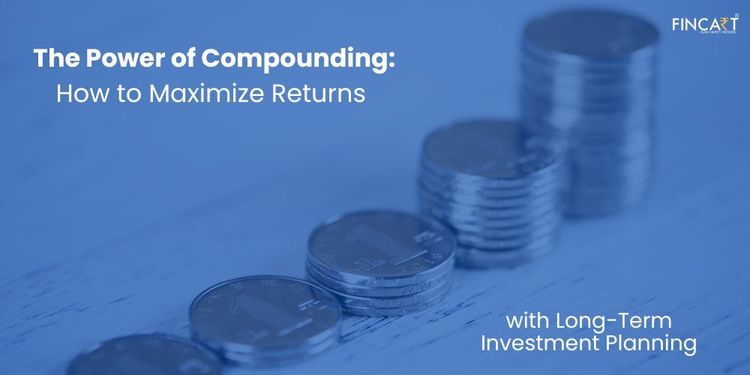Table of Contents
ToggleWhen investment returns are reinvested over time, additional earnings are generated. This is the power of compounding. Over time, compounding magnifies returns because it adds interest to interest. This concept is used to estimate an investment’s value through the power of compounding. Uncover its financial magic ahead!
What is the Power of Compounding?
The power of compounding meaning is simple as it is a financial phenomenon where the growth of an investment accelerates over time due to the reinvestment of both the initial amount and the accumulated returns. Time plays a crucial role in this process, allowing even small investments to potentially blossom into significant sums through the magic of exponential growth.
How Does Compounding Work in Investment?
The power of compounding in investment planning involves reinvesting earned returns, including both interest and gains, back into the original investment. As time progresses, this process generates a snowball effect, where the invested amount grows exponentially. The longer the investment horizon, the more pronounced the power of compounding becomes, showcasing its ability to amplify wealth over the long term.
What is the Formula for Compounding?
To determine the worth of an investment, you can use a power compounding calculator. An investment’s value is calculated after ‘n’ years at a specified interest rate. Compound interest is the basis for the power of the compounding calculator. In compound interest, interest earned on the principal is added to the principal amount at a compound interest rate to make high returns. Compound interest is calculated using the power of the compounding formula P [((1 + i)^n) – 1], where P is the principal, I is the annual interest, and n is the number of periods.
An individual can use the calculator to determine how much they would earn if they invested a fixed amount at a given interest rate. An investment can be calculated using this calculator. If they invest their savings, they can find out how much they will grow.
This calculator comes with the following components:
- The amount of investment one intends to make is known as the principal amount.
- An investment period refers to the number of years one intends to invest.
- A rate of return refers to the interest an investor expects to earn.
Ready to grow your wealth?
Partner with Fincart for expert investment planning and make your money work for you.
Strategies for Maximising Your Returns with the Power of Compounding
Here are the various strategies for maximizing your returns through the magic of compounding.
Start Early
Initiate your investments as soon as possible to harness the benefits of a longer time horizon.
Consistent Contributions
Regularly contribute to your investments to capitalize on consistent growth and accumulate more principal for compounding.
Reinvest Earnings
Reinvest dividends, interest, and gains to compound the existing investment, accelerating growth.
Compound Frequency
Choose investments with higher compounding frequencies (quarterly or monthly) to accelerate growth compared to annual compounding.
Diversification
Spread investments across various asset classes to minimize risk and tap into multiple avenues of compounding.
Stay Invested
Avoid frequent withdrawals; staying invested allows compounding to work its magic over an extended period.
Increase Contribution
Whenever possible, increase the amount you invest to amplify both the initial principal and future returns.
Long-Term Perspective
Embrace a patient approach, as compounding’s true power shines over longer periods, allowing for substantial growth.
Automatic Investments
Set up automatic contributions to ensure consistent investments without relying on manual actions.
Regular Monitoring
Review and adjust your investments periodically to ensure they align with your financial goals.
Tax-Efficient Strategies
Utilize tax-advantaged accounts to minimize tax implications and enhance overall returns.
Rebalance Portfolio
Periodically rebalance your portfolio to maintain an optimal asset allocation, maximizing potential returns.
Compounding in Different Financial Instruments
Compounding operates uniquely across diverse financial instruments, shaping wealth accumulation strategies
Savings Accounts
Interest compounds on your deposited funds, but due to lower interest rates, growth can be gradual.
Fixed Deposits
These offer fixed interest rates and compounding intervals, enabling predictable growth over a specific period.
Mutual Funds
With reinvestment of dividends and capital gains, mutual funds harness compounding for potentially higher returns over time.
Stocks
Capital appreciation and reinvested dividends drive compounding, where long-term investments yield exponential growth.
Bonds
Interest compounds on bond investments, yielding predetermined returns at maturity.
Real Estate
Property value appreciation and rental income reinvestment demonstrate compounding’s impact.
Also Read: Real Estate Investment Trust-Reit
Leveraging Compounding for Retirement Planning
When planning for retirement, it is wise to take advantage of compounding. An individual can potentially secure a more comfortable retirement by starting early, contributing consistently, and allowing investments to compound over time. The compounding effect helps turn modest contributions into substantial retirement funds, ensuring financial stability in the later years of life.
Online Calculators for Compound Interest
It is a handy tool to have a compounding calculator on hand. The following benefits are associated with the compound interest calculator:
Useful and easy to use
Calculators have no learning curve when it comes to using them. It is simply a matter of entering the three values. The amount of investment, the investment period (in years), and the expected return (in percent). Along with a graph, the calculator returns the values of total investment, wealth gained, and maturity value.
Calculates quickly and easily
Manually calculating compound interest and determining the final value of an investment takes a lot of time. It takes just a few seconds for compounding calculators to provide accurate results. By doing so, the investor saves time.
Planning for the future
Financial planning is easier with the help of compounding calculators. Before investing in an investment, investors can use the compound interest calculator to determine how much they will earn. By comparing all the plans, they can choose the most profitable one.
You can use it for free
You can use the calculator multiple times for free online. You are providing investors with cost-effective planning for the future.
Multiple scenarios can be compared
By tweaking the interest rate, investment amount, and investment time, an investor can run multiple scenarios. By comparing the scenarios’ results, he/she can determine the best investment strategy.
Benefits of compounding
There are many benefits of compound interest, a few of which are mentioned below:
- Exponential Growth: Through the repeated reinvestment of earnings, even a modest investment can grow significantly over time, showcasing the power of exponential growth.
- Passive Income Generation: Compounding generates additional income from accumulated returns, providing an extra source of passive income.
- Wealth Accumulation: Over the long term, compounded growth can amass substantial wealth, helping individuals achieve their financial goals. It is believed to be one of the top benefits of compounding.
- Mitigating Inflation: Compounded returns tend to outpace inflation, preserving the purchasing power of the invested funds.
- Long-Term Focus: Emphasizing long-term goals, compounding discourages impulsive decisions and encourages disciplined investing.
- Reduced Risk: The potential for higher returns reduces the need to take excessive investment risks.
- Early Financial Freedom: Starting early allows compounding to work its magic, potentially leading to financial independence sooner.
- Consistency Rewards: Regular contributions enhance the compounding effect, instilling disciplined saving habits.
- Retirement Security: Leveraging compounding in retirement planning can ensure a comfortable retirement by harnessing time’s potential for growth.
- Minimal Effort: Once investments are set up, compounding requires minimal active involvement, making it a convenient strategy.
Conclusion
The power of compounding can be incorporated into financial decisions in a way that will yield a cascade of benefits, ultimately fostering wealth, financial security, and a stable financial future in future.h




